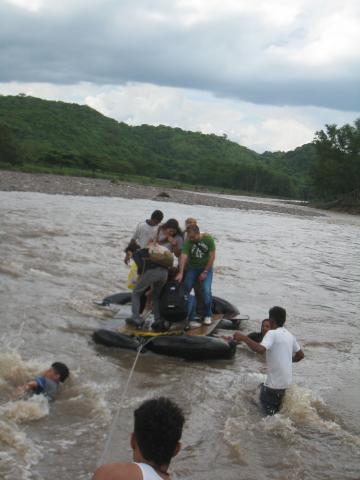Our foundation invests in innovative concepts, and the following blog by Alan Wright of SosteNica offers such a stellar example of this. Remember, you can invest in SosteNica directly or through our Charitable Remainder Trust (CRT), where you receive 5% interest on your investment for the rest of your life. (My mother supports SosteNica through our CRT, and so can you!) Here’s Alan……………
The beautiful lyrics of Pat Humphries’ “Swimming to the Other Side” took on new meaning when 14 Cornell students, along with SosteNica staff reached the middle of the Río Estelí only to find half the river yet to span. Nicaragua’s Pacific side rainy season, usually begins without much drama towards the end of May, picking up momentum in June, becoming quite volatile during the hurricane months of September and October. This year however, a warmer planet has sent huge volumes of rain onto the Central American nation earlier than expected, washing out the river crossing which separates the village of San Diego from Condega, its nearest small city.

SosteNica had organized a site analysis to be conducted in San Diego by three Cornell teams. One would study housing related issues. Another would tackle food security, while the third would examine “urban planning.” Nicaragua’s capital and largest city Managua, a maze of unplanned neighborhoods, was cobbled together after a devastating 1972 earthquake. Villages like San Diego never get urban planning expertise. The country is just too poor.
SosteNica and the Cornell students thought otherwise. Why should people live undernourished with inadequate housing, and no organizing design for their community? Are these necessities really limited by lacking economic resources? How much of San Diego’s problems derive from a lack of information, the group asked itself?
The three teams spent 12 days in Nicaragua, from May 21 through June 1, meeting with the residents of San Diego to discover what problems they suffered, and what resources might be available to them. They had been told that just over 100 families were crammed together in 60 homes, many of which were built of adobe, with their walls and roofs falling down. Cornell had sent an innovative proposal, to design and build using bamboo held together with a Buckminster Fuller type geodesic node which would afford low cost design flexibility and strength.
To their surprise, the teams discovered that the community built their homes from adobe for a very good reason — because the earth beneath their feet was a perfect blend of sand and clay, ideal for earth construction. True, the homes were falling down, but not because the walls were earthen, but because the people of San Diego had never been shown how to build a proper foundation to protect the earth block from moisture. As seasonal rains have increased flooding, the decay of walls has accelerated.
By the end of the twelve-day adventure, the students and their respective professional consultants in architecture, permaculture and urban planning, had come up with a plan that would contribute 42 new homes to the community. Each home would be surrounded by edible landscaping including fruits, vegetables and medicinal plants, a composting toilet, a grey water treatment system, rainwater caption, a fuel efficient cook stove, and a bread fruit tree to compliment their field crop diet of rice, beans and corn tortillas. The homes would be organized around a series of home clusters, villages within a village, with each cluster having its own communal garden.
To everyone’s surprise, the proposed house design had a sturdy rock foundation and stem wall, with crisp adobe block walls supporting a traditional looking clay tile roof. The design may prove to be more affordable than the newer cinder block and rebar structures going up in other parts of Nicaragua, while being more attractive, honoring the culture of San Diego, as well as being more pleasant to inhabit.
SosteNica plans to subsidize the eco-technologies for the 42 families, while providing the financing for micro-mortgages to build them with a 10-year repayment plan.
“Swimming to the Other Side” by Pat Humphries
We are living ‘neath the great Big Dipper
We are washed by the very same rain
We are swimming in the stream together
Some in power and some in pain
We can worship this ground we walk on
Cherishing the beings that we live beside
Loving spirits will live forever
We’re all swimming to the other side
I am alone, and I am searching
Hungering for answers in my time
I am balanced at the brink of wisdom
I’m impatient to receive a sign
I move forward with my senses open
Imperfection, it be my crime
In humility I will listen
We’re all swimming to the other side
On this journey through thoughts and feelings
Binding intuition, my head, my heart
I am gathering the tools together
I’m preparing to do my part
All of those who have come before me
Band together and be my guide
Loving lessons that I will follow
We’re all swimming to the other side
When we get there we’ll discover
All of the gifts we’ve been given to share
Have been with us since life’s beginning
And we never noticed they were there
We can balance at the brink of wisdom
Never recognizing that we’ve arrived
Loving spirits will live together
We’re all swimming to the other side
